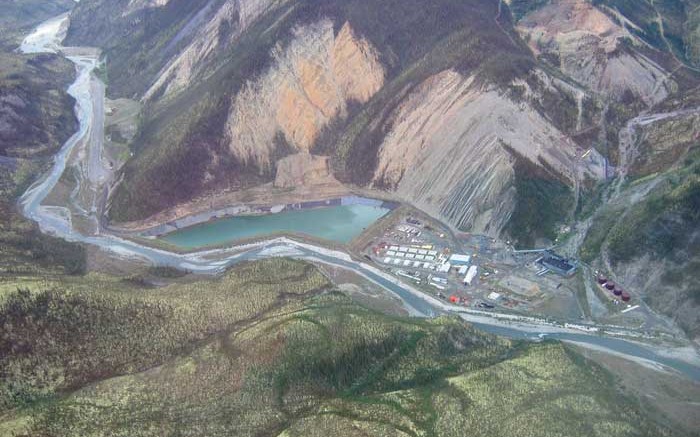VANCOUVER — It’s a tough market for juniors with development-stage assets, and that’s especially true for Canadian Zinc (TSX: CZN; US-OTC: CZICF) and its Prairie Creek polymetallic project, 500 km west of Yellowknife in the Northwest Territories. Prairie Creek boasts a large zinc-lead-copper-silver resource and offers a quick path to production, but its isolated locale creates unique challenges.
A rise in zinc prices would certainly help, though the industrial metal hasn’t really come to life over the past year despite positive buzz amongst industry analysts. So Canadian Zinc is approaching Prairie Creek from an optimization angle, which it hopes will boost the economics set out in a prefeasibility study filed in June 2012.
Vice-president of exploration and chief operating officer Alan Taylor says there’s plenty of room for improvement at Prairie Creek, which already features strong projected economic returns. The current mine plan envisions a 1,000-tonne-per-day mill that would produce zinc and lead concentrates without using cyanide. An average 92% of the silver values in the plant feed would also be recovered.
Prairie Creek would produce 60,000 tonnes zinc and 60,000 tonnes lead annually over an 11-year life based on 5.2 million proven and probable tonnes grading 9.4% zinc, 10.2% lead and 167 grams silver per tonne. Measured and indicated resources add 5.4 million tonnes of 10.8% zinc, 10.2% lead, 160 grams silver and 0.28% copper, while inferred resources tack on 6.2 million tonnes of 14.5% zinc, 11.5% lead, 229 grams silver and 0.57% copper.
“There’s a lot of optimization of underground mine methods,” Taylor explains during an interview, noting that Canadian Zinc suspects that long-hole stoping could prove a better alternative to the cut-and-fill mining methods assumed in the original prefeasibility study.
“We’re definitely still looking at a copper-silver concentrate and seeing how that might add value. We’ve been doing some marketing with the current concentrate specifics and they’ve been getting some serious consideration. On the opposite side we’re looking at near-site tertiary treatment to lower potential penalties. There’s also a lot of potential to improve the lead and zinc recoveries because we have both oxide and sulphide in our concentrates, so we’re trying to determine what mix would work best in that regard,” he adds.
Improved metallurgical recovery and mining methods could add value at Prairie Creek, but due to logistical challenges the company may have to counter-balance any changes with capital increases. Under the prefeasibility study the project would cost US$193 million to develop and carry a US$253-million pre-tax net present value at an 8% discount rate, along with a 40.4% internal rate of return and three-year payback.
Canadian Zinc might alleviate working capital concerns by building an all-season road to Prairie Creek. Current studies assume a 184 km winter road with two transfer facilities that provide temporary surface access to the site for at least two months a year. The company has initiated an environmental application for a year-round road, with a decision expected on the permit review within the next year.
With Prairie Creek’s optimization study results expected by year-end, Canadian Zinc is proceeding with the drilling and rehabilitation needed to get the project into production. In July the company closed a $15.8-million bought-deal offering wherein it issued 28.6 million units at 35¢ apiece, with each unit comprised of a share and half a share purchase warrant exercisable at 50¢. The placement included 15-million flow-through shares priced at 38¢ each.
A good part of the capital raise is earmarked for an underground development and drill program at Prairie Creek. The first stage would reopen and access the underground by dewatering and reinstalling electricity and ventilation to a 650-metre-long decline tunnel from 2006.
The company intends to complete a 6,000-metre drill program from underground stations at the end of the decline tunnel, in order to upgrade part of the inferred resources to the indicated category.
“We’re just in the process of mobilizing the underground drill. We recently awarded the contract, and we’ve got the supplies on the road to Fort Simpson,” Taylor says. “We currently have the three surface rigs, but we’ll need the underground equipment to complete the program. We’re basically finishing off what we started back in 2006–07, when we completed the tunnel parallel to the footwall. We’ve established three other underground stations we haven’t even drilled from yet.”
Although the dewatering process should only take “a week or so,” Taylor says that once the equipment is running it will be one of the program’s most important aspects. Canadian Zinc will perform hydrological studies to fine-tune its pumping requirements at the mine by monitoring the down-swelling of the groundwater curve. The company needs this process so that it can meet its water licence conditions.
Canadian Zinc shares have traded between 19¢ to 54¢ in the past year, and closed down 10% at 19¢ at press time. The company has 218 million shares outstanding for a $41-million market cap.
“The market is still soft right now, but the outlook for zinc seems to be positive,” Taylor says. “We’re one of the few junior resource companies that is actually spending money and moving ahead with both exploration and development, and the optimization study will give us a good handle on what sort of capital we need to raise to go into production. It hasn’t been easy, but we think things will get better and at that point we’ll be on the uptick, which is a nice place to be.”


Be the first to comment on "Canadian Zinc fine-tunes its plan at Prairie Creek"